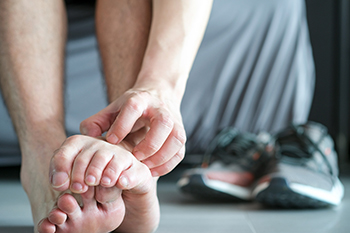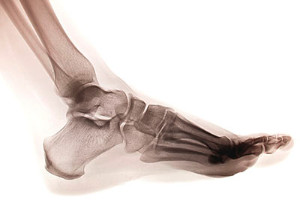Items filtered by date: October 2022
Categories of Athlete’s Foot

Athlete’s foot is a common skin infection that invades the feet. Research has indicated that approximately 10 percent of people who reside in North America are afflicted with this uncomfortable condition. There are four types of athlete’s foot categorized as moccasin-type, vesicular, interdigital, and ulcerative. The most prevalent type is interdigital athlete’s foot, which is found between the fourth and fifth toes and is caused by a fungus. Having an allergic reaction to fungal organisms is typically the culprit in obtaining vesicular athlete's foot and large areas are often affected when ulcerative athlete’s foot is present. The symptom that many people experience with athlete’s foot is severe itching between the toes and on the bottom of the feet. In severe cases, blisters may also form. Athlete’s foot is treated by a podiatrist, so it is suggested that you consult with this type of doctor if you have developed this foot condition.
Athlete’s Foot
Athlete’s foot is often an uncomfortable condition to experience. Thankfully, podiatrists specialize in treating athlete’s foot and offer the best treatment options. If you have any questions about athlete’s foot, consult with Dr. Mark Gagnon from Advanced Podiatry. Our doctor will assess your condition and provide you with quality treatment.
What Is Athlete’s Foot?
Tinea pedis, more commonly known as athlete’s foot, is a non-serious and common fungal infection of the foot. Athlete’s foot is contagious and can be contracted by touching someone who has it or infected surfaces. The most common places contaminated by it are public showers, locker rooms, and swimming pools. Once contracted, it grows on feet that are left inside moist, dark, and warm shoes and socks.
Prevention
The most effective ways to prevent athlete’s foot include:
- Thoroughly washing and drying feet
- Avoid going barefoot in locker rooms and public showers
- Using shower shoes in public showers
- Wearing socks that allow the feet to breathe
- Changing socks and shoes frequently if you sweat a lot
Symptoms
Athlete’s foot initially occurs as a rash between the toes. However, if left undiagnosed, it can spread to the sides and bottom of the feet, toenails, and if touched by hand, the hands themselves. Symptoms include:
- Redness
- Burning
- Itching
- Scaly and peeling skin
Diagnosis and Treatment
Diagnosis is quick and easy. Skin samples will be taken and either viewed under a microscope or sent to a lab for testing. Sometimes, a podiatrist can diagnose it based on simply looking at it. Once confirmed, treatment options include oral and topical antifungal medications.
If you have any questions, please feel free to contact one of our offices located in Crestwood, Orland Park, and Summit, IL . We offer the newest diagnostic and treatment technologies for all your foot care needs.
Foot Shape and Ancestry?

Some people think that foot shape may help to determine ancestry, despite the fact, there is no concrete evidence to support this. The type of arch one has may contribute significantly to the entire shape of the foot and differs from person to person. Research has indicated the arch affects the movement of the foot, and overuse can happen when the arch is too high or low. Additionally, the arch is responsible for pronation and supination of the foot and is a normal part of walking. This is defined as pushing off while walking or running, and the feet will naturally roll outward to balance the weight of the body. An abnormal foot structure may lead to the development of specific foot conditions that can include bunions, plantar fasciitis, and ankle pain. If you have questions about your foot structure, or if you have any foot conditions, it is strongly advised that you confer with a podiatrist who can eagerly address any concerns you may have.
If you have any concerns about your feet, contact Dr. Mark Gagnon from Advanced Podiatry. Our doctor can provide the care you need to keep you pain-free and on your feet.
Biomechanics in Podiatry
Podiatric biomechanics is a particular sector of specialty podiatry with licensed practitioners who are trained to diagnose and treat conditions affecting the foot, ankle and lower leg. Biomechanics deals with the forces that act against the body, causing an interference with the biological structures. It focuses on the movement of the ankle, the foot and the forces that interact with them.
A History of Biomechanics
- Biomechanics dates back to the BC era in Egypt where evidence of professional foot care has been recorded.
- In 1974, biomechanics gained a higher profile from the studies of Merton Root, who claimed that by changing or controlling the forces between the ankle and the foot, corrections or conditions could be implemented to gain strength and coordination in the area.
Modern technological improvements are based on past theories and therapeutic processes that provide a better understanding of podiatric concepts for biomechanics. Computers can provide accurate information about the forces and patterns of the feet and lower legs.
Understanding biomechanics of the feet can help improve and eliminate pain, stopping further stress to the foot.
If you have any questions please feel free to contact one of our offices located in Crestwood, Orland Park, and Summit, IL . We offer the newest diagnostic and treatment technologies for all your foot and ankle needs.
Why Do Stress Fractures Occur?

A very small crack on a bone can be referred to as a hairline or stress fracture. Stress fractures often occur in the feet and can affect one or more of the twenty-six bones in each foot. These tiny cracks typically result from repetitive movement and can be common among runners or people who participate in sports like basketball, tennis, and ballet. The symptoms can develop gradually and consist of pain that may subside after resting the affected foot, and the area may be swollen or tender. Relief and treatment often begin with stopping the activity that caused the fracture, followed by having an X-ray performed which can determine the extent of the fracture. As the swelling decreases and the pain subsides, it is helpful to reintroduce weight-bearing activities gradually. Staying active helps to stimulate the recovery process but it is important to refrain from high-impact activities. Please contact a podiatrist as quickly as possible who can properly diagnose and treat stress fractures.
Stress fractures occur when there is a tiny crack within a bone. To learn more, contact Dr. Mark Gagnon from Advanced Podiatry. Our doctor can provide the care you need to keep you pain free and on your feet.
How Are They Caused?
Stress fractures are the result of repetitive force being placed on the bone. Since the lower leg and feet often carry most of the body’s weight, stress fractures are likely to occur in these areas. If you rush into a new exercise, you are more likely to develop a stress fracture since you are starting too much, too soon. Pain resulting from stress fractures may go unnoticed at first, however it may start to worsen over time.
Risk Factors
- Gender – They are more commonly found in women compared to men.
- Foot Problems – People with unusual arches in their feet are more likely to develop stress fractures.
- Certain Sports – Dancers, gymnasts, tennis players, runners, and basketball players are more likely to develop stress fractures.
- Lack of Nutrients – A lack of vitamin D and calcium may weaken the bones and make you more prone to stress fractures
- Weak Bones – Osteoporosis can weaken the bones therefore resulting in stress fractures
Stress fractures do not always heal properly, so it is important that you seek help from a podiatrist if you suspect you may have one. Ignoring your stress fracture may cause it to worsen, and you may develop chronic pain as well as additional fractures.
If you have any questions, please feel free to contact one of our offices located in Crestwood, Orland Park, and Summit, IL . We offer the newest diagnostic and treatment technologies for all your foot care needs.
What Part of the Foot Is a Plantar Fibroma Found?

Plantar fibromatosis is a foot condition that affects the arch in the foot. It is also known as Ledderhose disease, and is characterized by lumps that form on the soles of the feet. These are considered to be benign growths, despite the severe pain they can cause. The symptoms that people experience who have this condition include foot and ankle pain, and a tingling sensation that can be likened to a “pins and needles” feeling. Mild relief may be found when soft insoles are worn in the shoes, which may help to cushion the feet. Also, there are specific stretches that can help the foot feel better overall. In severe cases, surgery may be necessary for permanent removal if milder treatments prove to be ineffective. If you have any of these symptoms, it is strongly advised that you schedule an appointment with a podiatrist as quickly as possible who can help you find relief.
A plantar fibroma may disrupt your daily activities. If you have any concerns, contact Dr. Mark Gagnon of Advanced Podiatry. Our doctor can provide the care you need to keep you pain-free and on your feet.
Plantar Fibroma
A plantar fibroma is a fibrous knot in the arch of the foot. It is embedded in the plantar fascia which is a band of tissue that extends from the heel to the toes along the bottom of the foot. There can be multiple plantar fibromas in the feet at the same time. There are no known causes for this condition. If you have a plantar fibroma, there will be a bump in the arch of your foot that cannot be missed. Any associated pain is most often due to a shoe rubbing against the nodule. Non-surgical options, such as steroid injections, physical therapy, and orthotics should be tried first. Surgery is a last resort and is the only thing that will remove a plantar fibroma entirely. Consult with a podiatrist for a proper diagnosis and to determine the treatment regimen that is right for you.
What Causes a Plantar Fibroma?
While there are no specific causes identified, a plantar fibroma can possibly come from genetic predisposition or the formation of scar tissue that forms from healing the tears in the plantar fascia.
What Are the Symptoms of a Plantar Fibroma?
There will be a noticeable lump in the arch of the foot that may or may not cause pain. If pain is felt, it is typically because a shoe is rubbing up against the lump or when walking or standing barefoot.
Treatment and Prevention
A plantar fibroma will not disappear without treatment, but it can get smaller and be a non-issue. If pain persists, a podiatrist examines the foot and when the arch of the foot is pressed, pain can be felt down to the toes. An MRI or biopsy might be performed to help diagnose or evaluate the plantar fibroma. The following non-surgical options are generally enough to reduce the size and pain of these nodules:
- Steroid injections
- Orthotics
- Physical therapy to help apply anti-inflammatory creams on the bump
Surgery is considered if the mass increases in size and the patient continues to feel pain after non-surgical methods are tried.
If you have any questions please feel free to contact one of our offices located in Crestwood, Orland Park, and Summit, IL . We offer the newest diagnostic tools and technology to treat your foot and ankle needs.

